by futuretimeline.net
2045
An inflection point for human-AI interactions
By 2045, artificial intelligence (AI) has reached a level of development that is beginning to reshape human society and culture in profound ways. This year marks the date of the so-called technological singularity postulated by futurist Ray Kurzweil.* Although Kurzweil tended to be overly optimistic in a number of specific future predictions,** his basic premise of exponential growth in technology proved to be accurate.
Speculation abounds during this time, much like the build up to Y2K in 1999, the Mayan calendar predictions in 2012, and other such dates. The Internet is abuzz with rumours and singularity-related memes. While most of this talk is unfounded hype – with life carrying on as normal for most people – the “normal” of 2045 is changing at a pace that would seem alarmingly rapid to observers from earlier decades. The leaps in technology from 2020 to 2045 have been much more noticeable than those during the same timespan from 1995 to 2020. The leaps now anticipated from 2045 to 2070 appear even greater still.
Robots, for example, are now widespread in everyday society, their numbers having expanded by orders of magnitude in preceding decades.** They are ubiquitous in factories, farms and industrial environments, eliminating much of the traditional manual work of humans.** Additionally, these machines have gained visibility in more public settings, giving a futuristic look and feel to many cities, towns and suburbs. Similar to how touchscreen smartphones moved from science fiction to reality some 40 years earlier, these robots are quickly becoming accepted as a routine part of life. This includes fully automated waste collection in streets and parks, robotic cleaners in offices and hotels, robot security patrols, robots for grocery and other deliveries. Such applications had begun to emerge during the 2010s. Following exponential growth, they are a common sight by 2045. Furthermore, bipedal humanoid form factors account for a growing percentage of newly deployed units, particularly in homes and other indoor settings.
With a ten-thousand-fold improvement in computing power compared to 25 years previously,* robots in 2045 can perform a multitude of tasks independently and without human supervision.
Many years previously, advances in deep learning and natural language processing had made it possible to generate portions of text indistinguishable from a human writer, which led to chatbots passing the Turing test, a major landmark in the field. Alongside this natural language processing, AI gained the ability to master real world environments and an increasingly diverse range of 3D objects. Whereas earlier robots had been limited to “fixed” movements, the generation now emerging had more dynamism and flexibility – adapting to new situations and solving more and more problems. These capabilities received a boost from 5G and then 6G wireless communication and the exponentially growing amounts of data being gathered from sensors, allowing robots to learn from their experiences and disseminate knowledge to each other.
In the past, limited processing power meant that robots would often spend minutes identifying an object or situation and the interaction required. By 2045, however, these calculations can be performed in near real-time, enabling a much more human-like response. Although a few technological hurdles remain, this is close to what many would consider to be artificial general intelligence (AGI).*
In addition to their cognitive abilities, some of the latest robots have gained extremely lifelike appearances. The most advanced models are now crossing the ‘Uncanny Valley’, with faces and bodies that appear almost – but not quite entirely – like a real person.* This bizarre and disturbing phenomenon is fuelling demand for more natural-looking facial expressions and limb movements. The problem is solved by user feedback (the robots can auto-detect a person’s emotional response – good or bad), combined with techniques such as motion capture, in a process that is somewhat similar to generative adversarial networks. These subtle iterations of data are used to determine the “best” appearance and movement, allowing gradual optimisation in successive generations of machines. 3D printed bones, amounting to all 206 in the human anatomy, along with new materials developed for more flexible skin and muscles, as well as more realistic eyes and teeth, help to iron out the remaining issues.

These cutting-edge prototypes are rarely seen by average members of the public, being mostly restricted to government, corporate, and research institutions, households of the rich and famous, TED talks and so on. Less advanced models are now relatively common in society, however. They are popular for those in upper-middle income brackets and are comparable in cost to a second car or similar major purchase. Their roles include household chores such as cleaning, cooking and tidying, as well as looking after children and elderly family members.*
Although typically geofenced within the owner’s property and/or local neighbourhood, these androids can also be seen further afield. They serve as excellent training partners on sports grounds, running tracks, parks and other leisure settings. Being able to replicate movements, it is possible to play against the recreation of a tennis champion, for example – or fight against a famous boxer. With the right motion capture, an owner can even play against a version of themselves if they desire.
Androids had emerged in the sex industry some decades earlier, though in rudimentary forms with limited functionality. The sex robots of 2045 are incomparably more sophisticated and engaging, to the point that many customers (mostly men) are forming long-term relationships with machines. Human-robot marriages are legalised in some jurisdictions in the latter half of this decade.**
There are many moral, ethical, legal, economic and philosophical issues around the proliferation of robots in society – all of which contribute to a growing sense of “future shock” around this time.
Other singularity-like effects are emerging in 2045. This includes the ever more rapid progress of brain-computer interfaces, enabling deeper integration of AI and human intelligence, going beyond medicine and into consumer uses such as gaming and VR, as well as education. On-person technology in general is becoming exquisitely compact and miniaturised – such as bionic eyes nearing human levels of visual acuity* and single-chip devices now approaching the size of individual blood cells.* Meanwhile, the option to extend one’s lifespan appears to be a realistic prospect, thanks to recent success in human rejuvenation trials.
The rapid growth of AI and robotics, alongside many other disruptive technologies, is occurring at a time of geopolitical turmoil, as the world grapples with a convergence of social, economic and environmental issues the likes of which have never been seen before. This volatility and the sheer pace of change is creating a “mental blur” for many people in 2045 – a sense that humanity is reaching a pivotal moment in history.
Homosexual discrimination has declined substantially
In 1800, more than 120 countries had laws against homosexuality. This number increased over the next century, peaking at 160 in the 1920s.* The mid- to late-20th century saw great progress in human rights, culminating in the first gay marriages during the early 2000s.*
With the floodgates now opened, many more nations began to allow same-sex couples to form civil partnerships, or full marriages, including the United States.* This trend was reinforced by the continued spread of democracy and the rule of law,* better education and rapid societal changes wrought by the Internet and social media. Younger generations in particular were more open, liberal and willing to support such policies.**
By the 2040s, more than half of the world’s countries allow same-sex marriage, while the overwhelming majority have decriminalised homosexuality. Only a handful of hard-line, authoritarian regimes – mostly in Africa and the Middle East – continue to outlaw the practice.
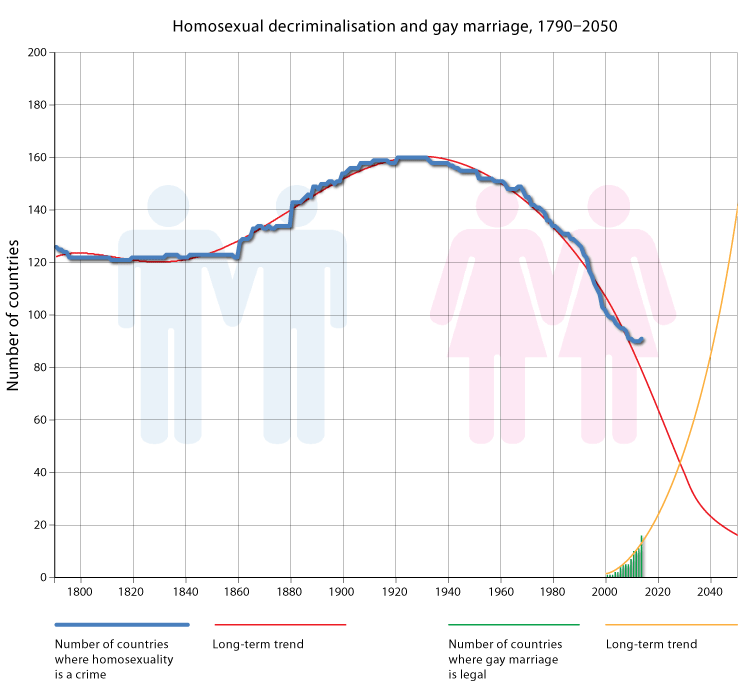
Air accident fatalities have been eliminated
Recent decades have seen an explosion in the level of computer control in vehicles of all types, greatly reducing the need for human involvement.* This includes the aviation industry, which has become highly automated.** Although manned crews may still be present, their roles are limited and supervisory, with only minimal if any need for intervention during the flight process. On the ground, airport infrastructure and navigation systems have seen major overhauls, leading to vastly improved traffic management and safety.*
Revolutionary new materials (such as graphene) – in combination with self-healing, nano-sensors and other systems embedded throughout the wings and body – have largely eliminated the structural failure issues that plagued earlier generations. Most aircraft now run on purely electric systems, without the need for dangerous and combustible liquid fuels.*
Hijacking and violent incidents, meanwhile, are now practically impossible, due to the sheer level of surveillance and security in place. Quantum encryption has made hacking of navigation systems difficult if not impossible.
Consequently, air crashes involving passenger deaths in large commercial aircraft are now almost unheard of in the news.** The age-old phobia of flying will soon become a thing of the past. In addition to safety, the rise of computer intelligence in aircraft design is leading to improvements in overall comfort experienced by travellers.*
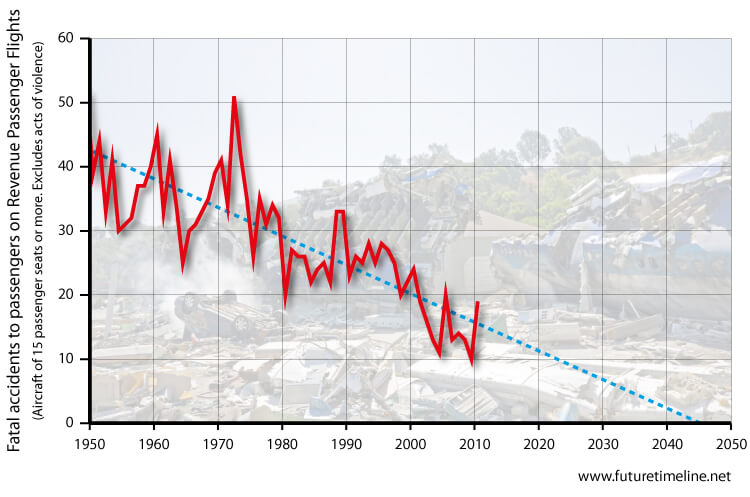
The Chūō Shinkansen high speed maglev route is complete
Tokyo and Osaka are now connected by a direct high-speed maglev route – the Chūō Shinkansen. This megaproject began construction in 2014, at a cost of over 9 trillion yen ($115bn). By 2027, the first trains were running between Tokyo and Nagoya,* and by 2045 the route has been extended to Osaka,** with trains travelling beneath the Japanese Alps (Akaishi Mountains). The first generation of these vehicles reached 313 mph (505 km/h), but newer and even faster designs are now in use.
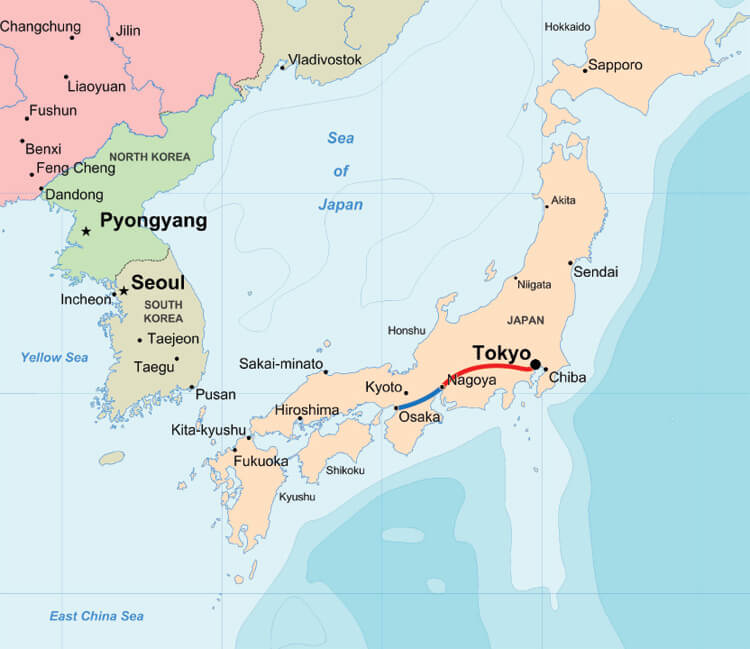
Gulf Coast cities are being abandoned due to super hurricanes
The rapid growth of CO2 emissions has led to rising sea levels, a warming of coastal waters and a more volatile climate system. In the Gulf of Mexico, a new category of “super hurricane” has emerged. This is becoming a regular occurrence by now. These extreme weather events are nightmarish in scale and intensity. At their peak, winds of 200mph bring untold devastation. Trees are uprooted and hurled like matchsticks, while skyscrapers visibly sway. Storm surges and flash floods travel up rivers with surreal speed, overwhelming defences and bringing waves tens of metres high. Damage from these and various other disasters has run into hundreds of billions of dollars. A number of Gulf coast cities are being permanently abandoned during this time, including Houston and New Orleans.**
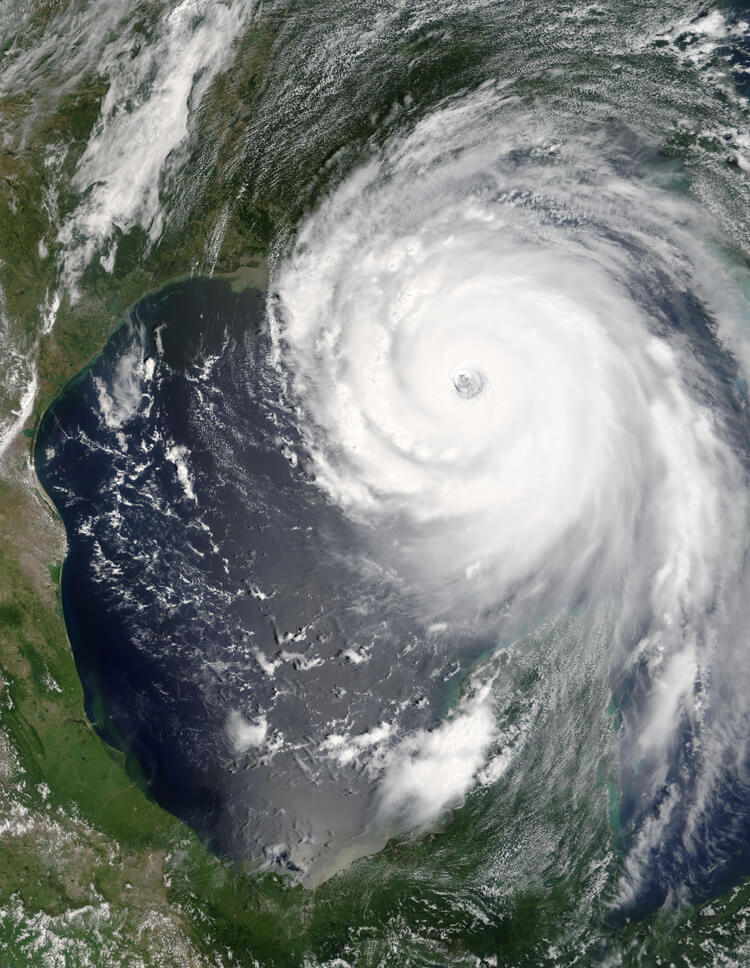
Apollo 12’s third stage returns to Earth
In November 1969, the Apollo 12 Saturn V blasted off towards the Moon. This rocket consisted of a three-stage launching system. While the first and second stage dropped back to Earth after launch, the third stage (S-IVB) was used to propel the docked Apollo Command Module and Lunar Module into a lunar trajectory.
In 2002, amateur astronomer Bill Yeung discovered what appeared to be a 30-metre (100 ft) asteroid in orbit around the Earth. Initially, it was believed to be a second natural satellite of Earth (the Moon being the first). However, later measurements of the electromagnetic spectrum were consistent with titanium dioxide paint used for the Saturn V rockets. Back-tracing its orbit showed that the object had been orbiting the Sun for 31 years and had last been near Earth’s vicinity in 1971. This seemed to suggest it was part of Apollo 14, but NASA knew the whereabouts of all hardware used for that mission – the third stage, for instance, was deliberately crashed into the Moon for seismic studies.
Another explanation emerged that it could be the S-IVB third stage for Apollo 12. NASA had originally planned to dump this spent component into a solar orbit, but an extra-long burn of the ullage motors meant the remaining propellant could not provide enough energy to escape the Earth–Moon system. Instead, this stage ended up in a highly erratic orbit around the Earth, after passing by the Moon.
Sure enough, this antique space junk, with an empty weight of 9,600 kg (20,000 pounds), would return to Earth during the mid-2040s, after drifting for over 75 years.* Objects with similar mass tend to impact Earth’s surface about once every 10 years.
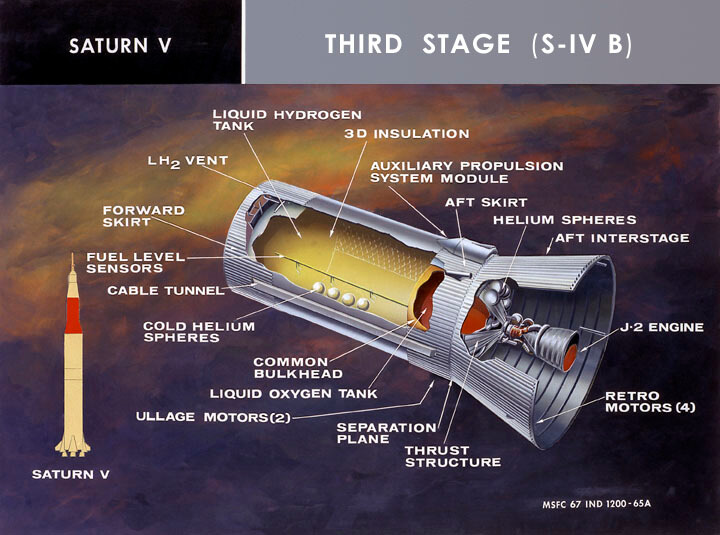
Total solar eclipse in the USA
A total solar eclipse occurs on 12th August 2045; the fourth longest of the 21st century. It is visible throughout much of the continental United States, with a path of totality running through California, Nevada, Utah, Colorado, Kansas, Oklahoma, Arkansas, Mississippi, Alabama and Florida. The eclipse is greatest over the Bahamas, before continuing over the Virgin Islands, Hispaniola, Venezuela, Guyana, Suriname, French Guiana, and Brazil.
The path of totality is witnessed over many major cities – including Reno, Salt Lake City, Colorado Springs, Oklahoma City, Tulsa, Fort Lauderdale, Miami, Orlando, St. Petersburg, Tampa, Nassau, and Santo Domingo. It lasts for at least six minutes along the part of the path that starts at Camden, Alabama, crossing Florida and ending near the southernmost Bahama Islands. The longest duration of totality is six minutes and 5.5 seconds, located at the coordinates 25°54.594’N 78°32.19’W, which is over the Atlantic Ocean east of Fort Lauderdale and south of Freeport, Bahamas.* A solar eclipse with a very similar path occurs in 2017.

The Boeing B-52 Stratofortress is retired from service
The Boeing B-52 Stratofortress was an American long-range, subsonic, jet-powered strategic bomber. Designed and built by Boeing, it was operated by the United States Air Force (USAF), with official introduction in 1955. Capable of holding up to 32,000 kg (70,000 lb) of weapons, it had a typical combat range of more than 8,800 miles (14,080 km) without aerial refuelling. A total of 744 of the aircraft were built, with the last one delivered in 1962.
The strength, reliability and versatility of the B-52 allowed it to become the backbone of the U.S. Air Force and a veteran of numerous wars. It played a key role during the Cold War – carrying nuclear weapons for deterrence and standing on alert, ready to conduct “doomsday missions” if necessary; though it only ever dropped conventional munitions in combat. During the 1960s, it performed large numbers of conventional strikes in Southeast Asia, pounding enemies with massive firepower.
While some variants were retired, the B-52 continued to see active service for many more decades, undergoing a series of upgrades and modernisations with new avionics, equipment and weapons. B-52 strikes were an important part of Operation Desert Storm (1991) and Desert Strike (1996), the latter including a 34-hour, 16,000-mile round trip from Guam – the longest distance ever flown for a combat mission. B-52s also contributed to Operation Enduring Freedom in Afghanistan/Southwest Asia (2001) and Operation Iraqi Freedom (2003).
Superior performance at high subsonic speeds and relatively low operating costs continued to keep the B-52 in service, despite the introduction of more advanced aircraft. As of 2015, 58 were in active service with 18 in reserve. After being upgraded again, it would serve until 2045 before finally reaching the end of its life, an unprecedented 90 years after introduction. The B-52 is replaced by the Northrop Grumman B-21 Raider.*

Credit: Allen J.M. Smith
2045-2049
Major extinctions of animal and plant life
By the end of this decade, many well-known animal species are going extinct, or have declined in such numbers that only those in captivity are now remaining.
Off the eastern coast of Australia one of the world’s greatest natural wonders – the Great Barrier Reef – has been almost completely destroyed, with less than 2% of coral remaining.* Rising levels of greenhouse gases have made the water too acidic for calcium-based organisms to grow.* Dumping of dredged sediment to help create the world’s largest coal port has caused further damage.* Most of the colourful fish for which the reef is famous have also disappeared. On land, 50% of the continent’s 400 butterfly species have
In Europe, an astonishing 50% of amphibians have disappeared due to pollution, disease and loss of habitat including many previously common species of frogs, toads, salamanders, newts and caecilians.* More than 20% of bird species have been lost, and around 15% of plants.
In South Africa’s Kruger national park, a major conservation area, nearly 60% of the species under its protection have been lost. In the same region, 35% of proteaceae flowering plants have disappeared including the country’s national flower, the King Protea.*
In South America, nearly half of the Amazon rainforest has been destroyed, with more than 2,000 native tree species becoming extinct.
In Mexico, nearly 30% of animal species are either extinct, or critically endangered.
In Southeast Asia, the Indian elephant is on the brink of extinction. Once a common sight in this part of the world, it has declined in huge numbers due to poaching for the ivory of its tusks, loss of habitat, and human conflict.
In the Arctic, nearly 70% of polar bears have disappeared due to the shrinking of summer ice caused by global warming. By 2080 they will disappear from Greenland entirely, and from the northern Canadian coast, leaving only dwindling numbers in the interior Arctic archipelago.
Many other well-known species of fish, bird and mammal become critically endangered around this time.
This period is often referred to as the Holocene extinction event. As a direct result of human influences, the rate of species extinctions this century is between 100 and 1000 times the natural “background” or average extinction rates in the evolutionary time scale of Earth.

Credit: Elisei Shafer





